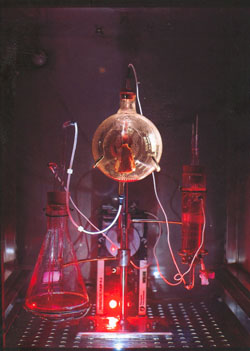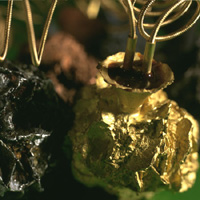Crystal growth, both natural and synthetic, has provided the basis for my current work. Presentation of the crystal as a living being that requires necessary progressive encouragement, allowed me to draw comparisons between embryo growth and crystal development. The chemical make up and crystal habit of the stone became reminiscent of the DNA structure, and the concept of the human womb was portrayed as the natural fractures and cavities within the lower surface of the earth’s crust, where the chemicals combined and create the final outcome, the crystal. The proposition of mother earth providing a womb for crystal growth and the fertility of the earth is also supported by the theories of ancient alchemists, who believed that every organic object has its own natural environment. The Biojewellery project was launched in 2006, and involved the bioengineering of couples bone cells to grow human bone. This was then combined with precious metals to create unique, sentimental wedding rings. The project was developed by tissue engineer, Dr Ian Thompson and jewellery students Nikki Stott and Tobey Kerridge. Biojewellery is particularly significant to my current practice, as it focuses on growing human bone, an unusual jewellery aesthetic, which is then fashioned into sentimental rings, thereby altering the general feeling towards the use of this material as a decorative medium. The biojewellery team claim that “art has a valid and necessary contribution to make to scientific progress, as does science to creative endeavor” (www.biojewellery.com), which I feel has appropriate importance to my work in relation to learning through art, and creating through learning.

The Tissue Culture and Art project has been of great interest and inspiration to me throughout the last 3 years. This innovative project was established in 1996, by Finnish born tissue engineering artist, Oron Catts and English born wet biology art practitioner, Ionat Zurr. Their aim was to investigate the use of tissue technologies as a medium for artistic expression and discussion, by culturing and growing animal tissue. They created living sculptures, which confront issues relating to the human treatment of animals and ethical issues surrounding biotechnology. The main concept included the exploration of the human relationship with life, through the construction or growth of a new “species” of semi-living object. These characteristics became apparent in my work through the creation of my “unnecessary environments”, which require interaction in order to supply the pieces with some form of needless attention, such as irrigation.

My research led me to imply that synthetic crystal growth could be viewed as a form IVF, considering the intentional human mix of chemicals and the replicated natural conditions of temperature and pressure allowing the artificial impregnation and resulting in crystal growth.
Personally, the natural metamorphism process of rock suggests a parallel to the alchemists’ idea of transmutation of one element into another. Their symbolic view involved the transmutation of base metals into highly prized gold, signifying the transformation of the alchemist’s soul into spiritual gold. Whilst I did not turn lead into gold, I did refer to this concept by using lead, silver and gold in my work. I felt that the intentional graduated use of these metals successfully signified their societal value, with relation to the stage of development in which I have captured my pieces within a shell of resin.
I consider the secret symbolic language used by alchemists fascinating and I feel it amplifies the preciousness of this spiritual science. However, I felt a stronger connection with the visual language of certain materials combined with basic symbolic shapes to be successfully expressive of my themes. The alchemical symbol of the eye became significant during the creation of the “Life-form” series, as I felt the inclusion of this element would further accentuate the suggestion of life, completed physical development and communicate the precious alchemic language for protection.
Dutch jeweller, Ruudt Peters, created an alchemy based series called “Lapis”, in 1997. With the formation of his own raw materials and development of an intricate process, he fused together several different minerals, with substances such as sulphur or beeswax. The process consisted of a combination of minerals that Peters considered to be masculine, such as sharp-edged, angular shapes which shatter, and those that he perceived as feminine, rounded shapes with soft, crumbling edges. Alchemic stages describe the titles of these pieces including; “Prima Materia”, “Solutio”, “Albedo”, etc. Peters transformed or transmutated these lifeless materials, instilling them with gender and considered the finished jewels as living beings. These entities then required a “natural” habitat, whilst their appearance was altered overtime due to wear and erosion. This concept is the basis of my silver “life form” pieces that are eroding and continuously changing, due to the addition of a saline solution.

Reflecting upon the concept of growth, I felt the theme of plant cultivation or the use of hydroponic equipment would be an appealing option for my degree exhibition. I decided to use an indoor greenhouse, or grow tent, which I thought would effectively communicate the concept of growth and nurturing. Also, the use of hydroponic lighting within the tent structure will create a mysterious glowing atmosphere on and around my work.
Correlation between raw and cut, or fashioned gem stones, with relation to structure, preciousness and value, was also of interest to me. The process of raw to facetted became descriptive of a lifecycle, considering conception, development, and the final stage in the crystal’s growth, viewed as maturity. This sequential narrative is also suggestive of an alchemist’s/scientist’s methodical experimentation and is reflected in the three stages of my work “Alchemy Life-forms”, titled “Raw State”-(fertilisation), “Transitional State”-(growth) and “Perfect State”-(maturity). I chose to use three shapes of gemstone, facetted, cabochon and uncut, to impersonate a flora lifecycle of seed, bud and flower. The red rubber tubing I used to aid the grip of the Life-forms on the silver jewellery attachments, became indicative of the human belly button and umbilical chord, further emphasising the idea of birth and creation.
“The Ring of Transmutation” is an intertwined three banded ring, consisting of my three value-symbolic Alchemy metals, lead, silver and gold. The intentional interlocking of these contrasting metals in the same ring confuses its sense of worth due to the forced collaboration of high prized gold beside the worthless lead, whilst the silver band acts as a mediator.
Through my work I feel I have blurred the boundaries between artificial and natural materials, alive and inanimate, art and science, creating “genderless”, eccentric amulet objects, which challenge the relationship between art entity, body adornment and the viewer/ wearer.